
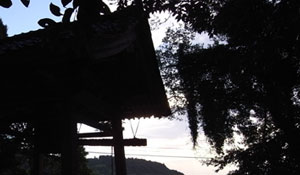
|
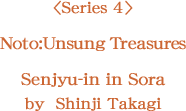 |
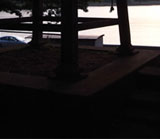 |
At handmadejapan.com we have been introducing various skilled handmade crafts since 2000. We have sort to expose the essence of those crafts which are characterized and deeply rooted in the areas where the craftspeople live, are affect by local climate and history. And at the same time there has been a chance to enjoy the individual qualities of ceramics both rustic and fine, cloth, paper and items made of bamboo, too. In a series of ten articles under the heading of Noto: Unsung Treasures, the architect Shinji Takagi, who was born and raised in Wajima in Ishikawa prefecture, seeks to identify some of the interesting buildings and their background, old local customs and various pieces of engaging landscape, all of which might not make it into a tourist guide but are nevertheless of considerable interest. At present I'm living in Wajima on the street along which the Morning Market is held but ever since I was a child I've lived in sight of the Japan Sea and have been aware of its ever-changing moods through the seasons. The western shore of the Noto Peninsula facing the Japan Sea is known as Soto-ura and is notoriously rugged and stormy when compared to the eastern coast known as Uchi-ura, which has a much calmer character with houses nestling comfortably along its coastline. Here and there along the coast the Tateyama range of high mountains in Toyama can be seen across the waters of Uchi-ura. In spring the view of these peaks is particularly fine but such a sight is said to be followed more often than not by rain. Following every twist and turn, the Uchi-ura coast road is punctuated by settlements and although small groups of elderly folk can sometimes be seen, children are conspicuous by their absence. It was this lack of small children in the area which led to the 2001 suspension of the Kanshugyo ritual that reputedly dated back 250 years and was held in Sora. Initially the ritual was seen as a way of introducing children of 12 to the rigours of public life and service. About ten years ago the poet and scholar of Buddhism, Malcolm Ritchie and his wife came to stay in Sora in the Uchi-ura town of Anamizu. They got along really well with the elderly occupants of this now sparsely populated community and on returning to his native Scotland, Malcolm wrote about their stay in his book Village Japan. It is a wonderful account of the warmth and humanity of the elderly locals who now occupy villages to which young people have never returned-one of the hidden drawbacks of Japan's post-war period of rapid economic growth. |
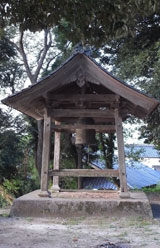 |
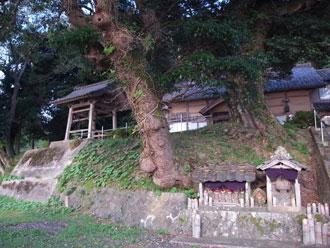 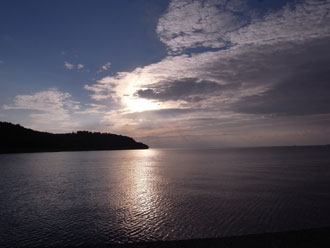 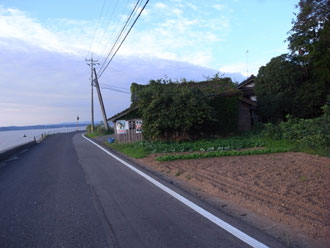
|
A few years later, the Richies returned with a friend Don and his wife and together they spent a whole summer living in Senju-in, a temple which had fallen into disuse and was uninhabited. While they were there they did some repairs and the chanting of the Sutras and the ringing of the temple bell every evening became part of their daily routine. The sound of the bell could be heard resonating throughout the usually quiet streets of Sora and it seems that the locals would turn to face the temple and put their hands together in silent prayer. Not so long ago I went to Scotland and visited the Richies who live on the Isle of Arran. The trip proved to be something of a revelation. Arran is probably about the size of Noto Island. There are no coastal defences around Arran but instead the shore is a continuous natural reef. With its green pastures and the occasional farmhouse, time seems to have stood still in this sparse tranquil landscape. Henry, a friend of the Richies, makes bagpipes. When I visited this former hippie's workshop, Henry with a wry smile said “I work between tea breaks!” I was only on Arran for a short time but it seemed to me as though all was well with the World there. And I will never forget the smiling faces of the enchanting children looking out of the windows of the school bus as it made its way from village to village around the island. Shinji Takagi---Architect Born in Wajima in 1942. Worked on many projects using local materials and true lacquer for shops, houses and a variety of interior design schemes. Principal work includes Yuyado Sakamoto in Suzu: the repair and renovation of the true lacquer craftsman's house, Nurishi no Ie in Wajima: Meiso no Yakata in Toga, Toyama prefecture: the store Kombuya Shirai in Nanao and Kanazawa: a store selling Japanese candles, Takazawa Shoten in Nanao. Member on the Wajima City Council for the Protection of Cultural Properties Committee. Director of the NPO, Ishikawa Reed Thatch Culture Study Group. Bill Tingey---Translator Chief Designer to David Hicks in London before moving to Japan in 1976 and gaining a Masters Degree in History of Architecture. Worked in Japan as a photographer, designer, writer and translator. Returned to UK to continue work in 2000. |
| ( 2014/10 Yuko Yokoyama) |
|
(C)Copyright 2004 Jomon-sha Inc, All rights reserved. |